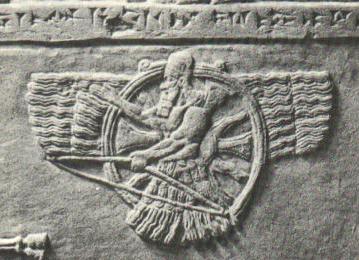Ancient Psychedelia: Alien Gods & Mushroom Goddesses
Online Book - Chapter 5, Page 71
Back to Online Book Mainpage / Next Page (Chapter 5, Page 72)
| The Asuras of the Vedas are the roots for Ahura Mazda. Ahura Mazda is associated with Mithra, as Varuna is to Mitra. (41) We also get the name of the Assyrian god Ashur (also Shamash) from this same word sound, depicted inside a winged disc and often carrying a bow (21a, b). (42) (21b) Ashur / Shamash North-West Palace of Ashurnasirpal II at Nimrud c. 865-850 BC  (21a) Ashur / Shamash c. 900-800 BC Egyptologists have vocalized the name of Osiris in various ways as Asar, Yasar, Aser, Asaru, Ausar, Ausir, Wesir, Usir, Usire or Ausare. (43) It’s possible that the Assyrians, who were engaged in battle with the Hindus, had been given the title the “asuras” in the Vedic literature. David Frawley lays out this assertion in Gods, Sages and Kings, however, it appears to me that we are dealing with a fungal kingdom and not a mortal one. |
Soma, Food of the Gods Soma has been thought to be the A. muscaria by several authors since the publication of Soma by Wasson in 1967-68. First, we will look at the references to it, then read what some people have to say. Personally, I believe that “Soma” was made with A. muscaria, but A. muscaria was not Soma. I know I’m nitpicking here, but several authors have now stated their agreement with Wasson on this, and I must object here. The main reason I do not believe A. muscaria is Soma is because of all the cow references made to Soma. Cow dung only produces psilocybin mushrooms, not A. muscaria. Why do I believe then that A. muscaria is a part of Soma? Because of the coloration described, mostly. The reddish hue of the liquid when crushed and mixed with milk and honey is the main reason here. Otherwise, I would assume it was psilocybin, and not A. muscaria at all. I’m not sure how Wasson could overlook this when his book focused on Vedic lore, but this seems to be the case, initially. It is at present a commonly held belief by some scholars that Soma, the mushroom, was the bull because of the horns and how it pushes itself up from the ground. This has been used to explain one of the ways Soma is a bull and why it is described as a bull. Its “horns” are characteristic of its strength and how it pushes up from the earth. I personally don’t think any of these analogies have anything to do with why soma is the bull. Soma is the bull because of the cow goddess in the sky. God is a cow or a bull to the ancient people because mushrooms grow from cow dung. I don’t see it as being more complicated than that. Hymns which deal directly with Soma as a deity and as a sacrificial juice or milk will be covered next. The birth places of soma are numerous, on earth, in heaven, on mountains, in plants and in waters. Prayers for immortality are interesting here because they appear to be specific to the act of injesting, and not long life. Soma is Lord of Plants, which invites the idea of the fungal kingdom. It is a healer, an enricher and wealth finder. This is where we find the root of the idea of “good luck” and “lucky charms.” The devotee intoxicated on A. muscaria can imagine himself to be wealthy beyond his dreams though he is poor as a pauper. It also brings about love which invoked the idea of luck, “lucky in love” as they say: (4) With all thy glories on the earth, in heaven, on mountains, in the plants, and in the waters,— With all of these, well-pleased and not in anger, accept, O royal Soma, our oblations. (6) And, Soma, let it be thy wish that we may live and may not die: Praise-loving Lord of plants art thou. (11) Well-skilled in speech we magnify thee, Soma, with our sacred songs: Come thou to us, most gracious One. (12) Enricher, healer of disease, wealth-finder, prospering our store, Be, Soma, a good Friend to us. (RV1) Hymn XCI. Soma (41) ibid, 265 (42) ibid, 268 (43) https://en.wikipedia.org/wiki/Osiris |
Go Back to Page 70